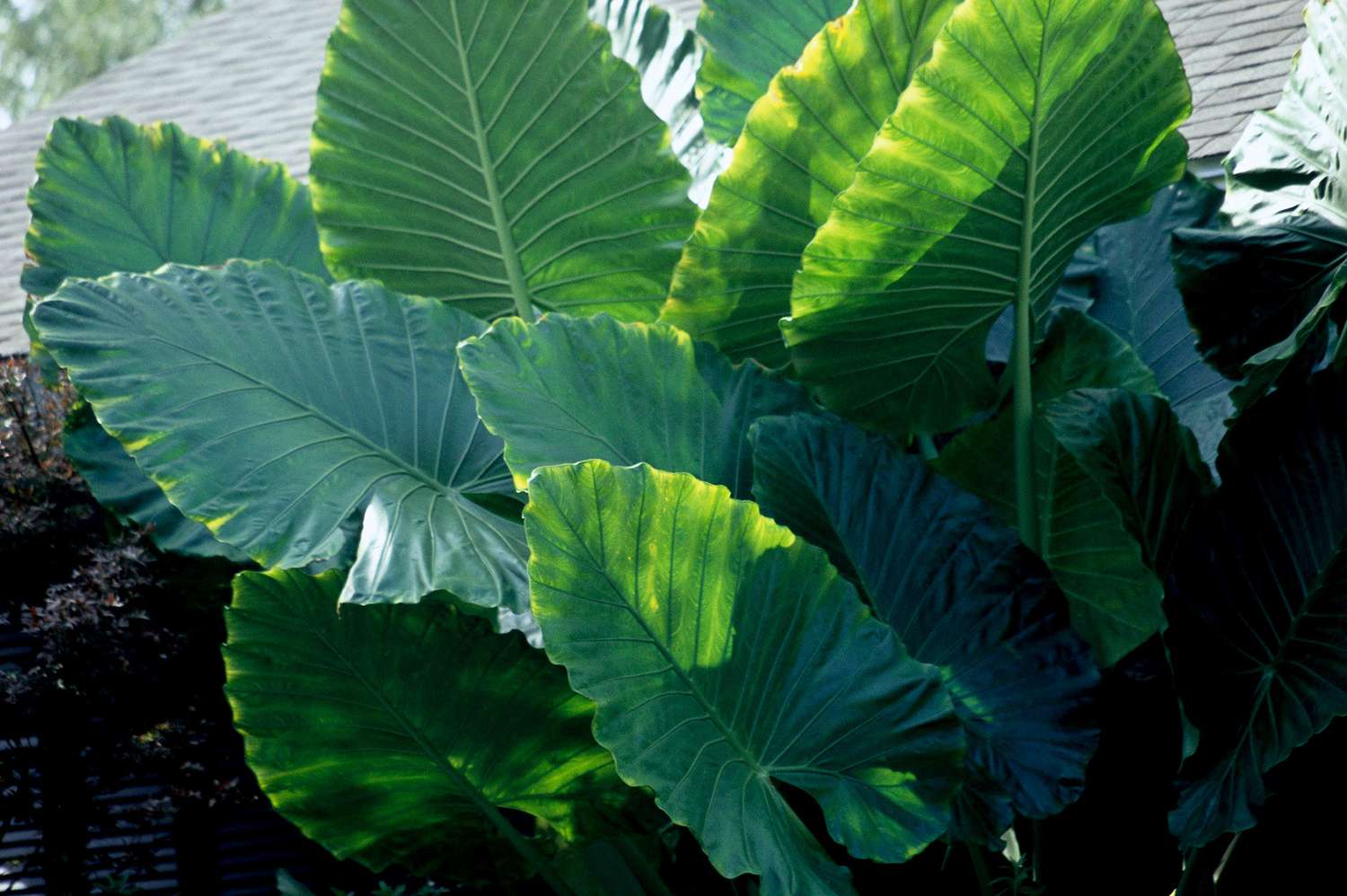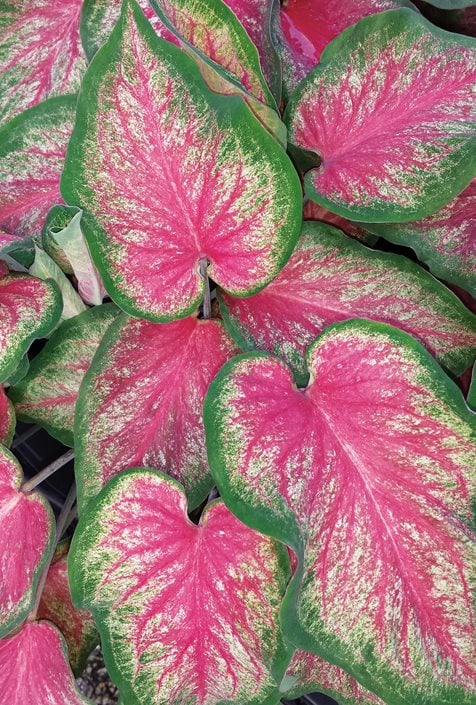elephant ear plant
Dark-leaved elephant ear growing in a water garden. Remove the plant from the container gently tease the roots.

Shop Elephant Ear Plant Thai Giant Shipping Included Strongly Deer Resistant And Repellent And Other Seeds At Harvesting History
Ad Riesenauswahl an Markenqualität.

. Elephant ears are tropical perennial plants grown for the appeal of their large leaves rather than their flowers. Elephant ears pair well with other foliage plants. The height of these plants varies anywhere from puny 2-feet tall.
They will make a beautiful dramatic statement in your home. The most common species of elephant ears are plants in the genera Alocasia Caladium Xanthosoma and Colocasia. Tropical plants like elephant ear plants need an.
The most recognized forms have heart- or arrow-shaped leaves often oversized with decorative veining inspiring the common name elephant ears. Elephant ear plants are species of flowering plants that produce aroid-type flowers. See below Description Alocasia spp.
Its leaves grow 3 feet in height and feet wide depending on species in favorable conditions. Most prefer full sun and well-drained soil as well as plenty of water and fertilizer. Ad Top-Marken zu Spitzenpreisen.
Plant size 15m height 15m spread Colocasia esculenta taro or elephant ears is grown for its huge and velvety heart-shaped leaves in shades of lime green purple or black. Elephant ear plants bring to mind lush tropical forests adding drama to both gardens and containers. Elephant ears rarely bloom indoors and flowers are uncommon when growing outdoors.
If conditions are cool or soil temperature is cold delay the planting until the soil has warmed to at least 65F 18C. As they come from tropical and subtropical regions Elephant Ears are heat-loving plants. Elephant Ear Plants gibt es bei eBay.
Elephant ear is the common name for several species in three plant genera Colocasia Alocasia and Xanthosoma. Alocasias are commonly planted as houseplants. Elephant ear plants belong to 2 groups of plants namely Alocasia and Colocasia which can be grown as houseplants or in the garden.
In USDA zones 9 through 11 elephant ears thrive in tropical gardens in partial shade or full sun. In colder climates you can grow elephant ear plants in the ground as annuals. There are 4 main types of elephant ear plants.
These are very similar to alocasia plants but are more commonly grown outdoors due to their larger size. Planting Elephant Ear Bulbs Growing elephant ear plants is easy. 1 You Could Be Watering the Plant Wrong.
Ad Top-Marken zu Spitzenpreisen. Is a genus of 80 species of tuberous herbaceous perennials from the tropical regions of Asia where rainfall is plentiful. Plants in the colocasia family are also referred to as elephant ears.
The elephant ear plants common name is often used for its different species in three plant genres- Alocasia Colocasia and Xanthosoma. Note that Colocasia are larger than the Alocasia and they are mostly planted outdoors. How to grow elephant ears in a garden Choose a well-drained partly shaded spot in the garden and prepare the planting area well by digging in Yates Dynamic Lifter Soil Improver Plant Fertiliser.
Plant your Elephant Ear tubers 5 in. Elephant ears are fantastic zone 9 plants and above you usually wont have to worry about frost in these zones. Elephant ear plant is not the only plant that has problems like its leaves turning yellow due to cold temperature.
Shrubs also face browning and yellowing due to cold or hot temperatures. The most common one is Colocasia esculenta also known as taro. They all have bold foliage and can add a tropical look to any garden.
Some species are widely cultivated and naturalized in other tropical and subtropical regions. These tropical plants grow best in warm temperatures and high humidity. The Elephant Ear Colocasia is a tropical plant that grows up to 9 feet 27 m tall and sprouts large arrow-shaped leaves that resemble the ears on an elephant.
The elephant ear plant is a tropical perennial plant grown for its elephant ear-shaped leaves. To grow these stunning plants plant the bulbs in the early spring with the right soil conditions. Many of these elephant ears produce white spathe and spadix flowers.
Many are even well adapted to growing in containers. If your elephant ear plant seems to be dying then you must be wondering what is going on. Their most common use however is as an accent or focal point.
Keep reading to learn more about elephant ear plant care and how to keep one healthy. Continue reading to get information about elephant ear plants and what can cause them to die. Arborvitae plant has the same issue and its foliage turns brown while some plants feel more cold air early which makes their leaves curl inward.
If you live in a colder climate consider keeping your elephant ear plant indoors at least to overwinter. Elephant ear plants can be used as background plants ground covers or edging especially around ponds along walkways or patio enclosures. Care for them properly with frequent watering and fertilizing to watch them flourish.
Keep a close eye on your outdoor temperatures as damage can occur below 50 degrees Fahrenheit. Elephant ears are actually a group of plants scientifically known as Alocasia Colocasia and Xanthosoma. Elephants-Ear Giant Taro Phonetic Spelling ah-loh-KAH-see-ah This plant has high severity poison characteristics.
The small flowers generally are unnoticeable under the vast leafy foliage. Elephant ears are fast-growing perennial plants. Colocasia Caladium Alocasia and Xanthosoma.
Elephant ear plant with blossom Colocasia is a genus of flowering plants in the family Araceae native to southeastern Asia and the Indian subcontinent. No plant satisfies the craving for a taste of the tropics like elephant ear plants. Whether youre growing colocasia or alocasia outdoors plant the tubers in rich well-drained soil and full to partial sun and water frequently in dry weather.
One of the first things that you. Dig the planting hole twice as wide and to the same depth as the root ball. Caladiums are generally Zone 10.
This should allow you to figure out what is wrong in your situation so that you can attempt to correct things. They may languish in Midwestern gardens until warm summer conditions begin and they will also falter when temperatures drop below 50F for prolonged periods of time. The elephant ear plant the common name for several tropical plant species called Colocasia Alocasia or Xanthosoma is named for the sheer size of its large leaves.
Elephant ear flowers usually have a white or green spadix surrounded by a spathe leaf.

100pcs Giant Elephant Ear Plant Fresh Colocasia Gigantea Huge Foliage Seeds Amazon Co Uk Garden Outdoors

Elephant S Ear Better Homes Gardens

How To Grow Elephant Ears Care Tips For Elephant Ear Plants Garden Design

Elephant Ears Bulbs Jumbo Spring Flower Bulbs Eden Brothers

Indoor Elephant Ear Plant Houseplant Care Of Colocasia


/elephant-ear-plants-2132884-15-c8a2fff099f24f75b9d7c69dc0caa0e0.jpg)
0 Response to "elephant ear plant"
Post a Comment